I recently learned that the tiny family cemetery near my office in suburbia is the final resting place of a Revolutionary War veteran.
The discovery got me thinking about burial locations of Revolutionary War veterans throughout Tennessee. I touched base with the Sons of the American Revolution and bought a book on the subject produced by the Daughters of the American Revolution in 1974. I compared the data in the book with information found on genealogical and cemetery websites.
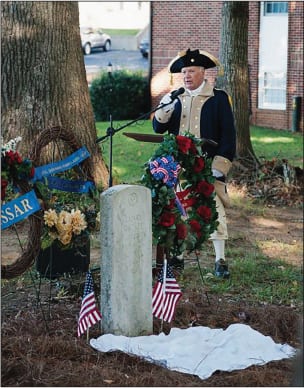
The first thing to become clear was the fact that there can never be a complete list of American Revolutionary veterans. Frontier military units often left incomplete records (or no records at all). We simply don’t know about many of the soldiers killed in battle or who died on the way home from fighting.
Our best data about Revolutionary War veterans are the transcripts of those who came forward decades later to claim government pensions. But what about those who died before the government started distributing payments? What about those who didn’t ask for a pension?
Also, the term “Revolutionary War veteran” doesn’t just refer to those who fought at Kings Mountain, Saratoga, Yorktown and in other battles to the east. Since the British supplied arms to Native American tribes and encouraged them to attack Tennesseans on the frontier, everyone who left home to fight against the Cherokee, Creek and Shawnee during this era is considered an American Revolution veteran.
So, given these considerations, about how many veterans are we talking about? And what can we say about where they are buried?
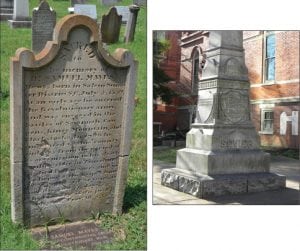
The book “Roster of Soldiers and Patriots of the American Revolution Buried in Tennessee” lists the names of about 4,500 veterans interred in Tennessee. In some cases, the book cites the county in which the person is buried; in rare cases, the cemetery is included. But most of the time, the lead compiler (Lucy Womack Bates) was unable to find that information.
Cross-referencing names from the book with information on the internet, I concluded that most Revolutionary War veterans in Tennessee are buried in unmarked graves. We might know the county or the general area where the man was buried, but we don’t know the exact location.
There are, however, many Revolutionary War veterans buried in marked graves in small family cemeteries such as the one near my office. There is an even smaller percentage of Revolutionary War veterans buried in church cemeteries.
Having said all this, here are some cemeteries in Tennessee that have concentrations of Revolutionary War veterans:
-
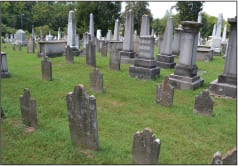
The remains of 15 Revolutionary War veterans are buried at Zion Presbyterian Church Cemetery in Maury County. The first person to be buried in Eusebia Presbyterian Church Cemetery in Blount County was Joseph Bogle. Born in Ireland, he fought for a Pennsylvania regiment and died in 1790. Over the years, Eusebia Presbyterian Church Cemetery has developed an image as a resting spot for Revolutionary War veterans. A written account says there are 15.
- Zion Presbyterian Church Cemetery in Maury County also contains the remains of 15 American Revolutionary War veterans, at least six of whom fought at Kings Mountain, a decisive battle near the North Carolina-South Carolina border.
- Nashville City Cemetery contains the remains of at least nine Revolutionary War veterans, including James Robertson and John Cockrill.
- The Revolutionary War Graveyard in Dandridge contains five such veterans. The best known of them is Adednego Inman, who was wounded at Kings Mountain and later survived capture by the Chickamaugans.
- Five Revolutionary War veterans are buried at Weaver Cemetery near Blountville. The Sons of the American Revolution will be marking these graves at a ceremony on Friday, Sept. 15.
- Four Revolutionary War veterans are buried in Franklin City Cemetery in Williamson County. Here are some notable Revolutionary War veterans buried in smaller cemeteries:
- John Sevier, the first governor of Tennessee, is buried beside the Knox County Courthouse.
- Jonathan Meigs led a group of soldiers that burned 12 British ships and took 90 prisoners in a New York assault known as “Meigs Raid.” After the war, the federal govern-ment sent Meigs to Tennessee to be a federal agent to the Cherokee. He is buried at Garrison Cemetery in Dayton.
- Brothers Isaac and Anthony Bledsoe fought in the Revolution and migrated to Middle Tennessee after the war but were killed fighting Native Americans shortly after they returned home. They are buried at the family ceme-tery at Bledsoe’s Fort Historical Park in Sumner County.
- David Campbell’s first-person account of battle is featured in a book called “The Battle of Kings Mountain: Eyewitness Accounts.” “I was not more than twenty feet from [Tory Capt. Abraham] DePeyster” when the commander surrendered, Campbell later said. Campbell is buried in Leeville Cemetery in Wilson County.
-
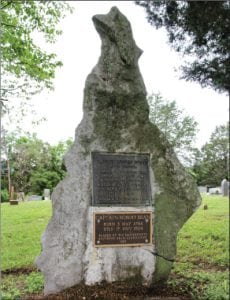
An impressive monument marks the grave of Robert Bean, Kings Mountain veteran who may have fired the shot that killed British Commander Patrick Ferguson. Capt. Robert Bean was also at Kings Mountain and may have fired the shot that killed British commander Patrick Ferguson. Bean’s grave can be found in Marion County at Bean-Roulston Graveyard.
- Pharaoh Cobb was a friend of Andrew Jackson who built one of Tennessee’s first horse tracks. His original gravesite had to be moved when the Tennessee Valley Authority created Cherokee Lake. You can now find the grave at Camp Davy Crockett, a Boy Scout Camp in Hawkins County.
I recommend you call your local Daughters of the American Revolution or Sons of the American Revolution chapter and research your corner of the state. What you will probably discover is that you have been driving right by a Revolutionary War veteran every day without realizing it. They are scattered all over the state as far west as Shelby County, which contains 19 such graves. In Kingsport, you will find the final resting place of James Gaines next to an apartment complex. A block from Cool-Springs Galleria in Williamson County is a small family cemetery that contains the remains of Revolutionary War veteran George Mallory.
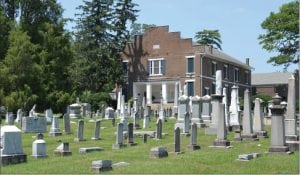
Many history enthusiasts know that Nancy Ward of the Cherokee Nation warned early Tennessee settlers about an impending attack by the Chickamaugans. The trader she warned, Isaac “Big Shoulders” Thomas, fought in the American Revolution and is buried in the heart of Sevierville.
My favorite Revolutionary War grave is that of Joseph Greer, reportedly a giant of a man who fought at Kings Mountain and was chosen to deliver the news of the victory to Congress. The journey, mostly on foot, from the southern Appalachians to Philadelphia was treacherous. On at least one occasion, Greer hid in a hollow log to avoid being captured by the enemy. When he got to Congress Hall, the sergeant-at-arms tried to block Greer’s way as he entered the chamber. He pushed the officer aside, announcing to Congress that an army of frontiersmen had crushed Patrick Ferguson’s Tory army at Kings Mountain.
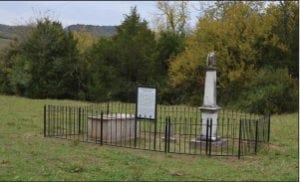
“With soldiers like him,” George Washington reportedly said, “no wonder the frontiersmen won.”
Joseph Greer is buried near Petersburg in Lincoln County. The last time I was there, the site was in good condition. But it isn’t easy to find. Do your research before you go, and don’t hesitate to ask for directions if you get lost.



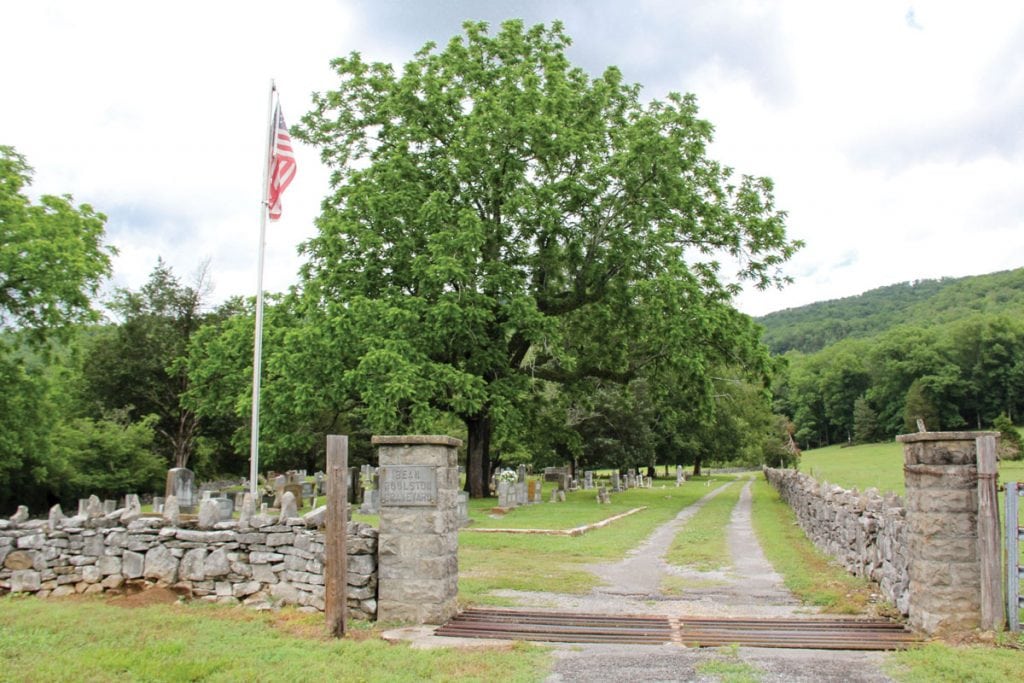
20 Comments
There is another little known cemetery in Murfreesboro that contains a Revolutionary soldier. The Lytle Cemetery, if it still exists. Capt. William Lytle served in three North Carolina regiments during the Revolutionary War and received land in Tennessee as payment for his services. The Continental Congress didn’t have any money, so they paid the soldiers in land. Lytle’s Cemetery is located at the Haynes Lumber Company on North Broad Street in Murfreesboro and is sandwiched between the company’s buildings.
Alder branch Baptist Church in Sevierville Tennessee has one Thomas Atchley I that would be my great-great-great-great-grandfather
It’s still there and currently under the stewardship of the Tennessee Society Sons of the American Revolution.
Elijah Harbour, my great, great, great, great, great grandfather spent 30 days in the militia in Kentucky fighting Indians in 1781 or so. He is buried just outside Collinwood.
I had several grandparent’s that fought in the Revolutional War. One is Henry Ellis and Underhill Ellis of North Carolina.
My relative, Lipscomb Norvell, was the first Revolutionary War Patriot to be buried in Nashville City Cemetery. He is located next to the city founder, Mr. Robertson.
My great-great-great grandfather, Edmond League, of Amelia County, Virginia fought with Captain Lewis Ford, Captain William Craddock and Colonel Holt Richardson in the Virginia Militia. His final discharge was October 25, 1781. They were at the battles of Hillsborough and Yorktown. He married Mary Beadle, whose father also fought in the Revolutionary War. Edmond League is buried in DeKalb County, Tennessee, having died on September 17, 1838.
It is he who enabled me to join the Daughters of the American Revolution.
Both sides of my family won American Revolution. War land grants to come to Tennessee. Henry and son Parrish Lankford are probably burried on their old farms, down here in Dickson County. We have several vets, burried down here. They were from Sedley, Va. . John Reeder fought in the Trenton, Eweing NJ area around their Rose Hill plantation. It is still there and is now some kind of minium security prison and training farm. Their relatives got to their land grants, down here in Dickson and are buried here. They were friends with and coming down here with theSeigal, of HIS, Henry I Seigal clothing factory in Dickson. Their family originally came from Amsterdam, we think. The Dutch King gave them 600 acres of land he had bought from the Lanapi Indians. We have been in Tennessee, for a long time.
One of my favorite headstones at Nashville City Cemetery tells a story. It reads in full “1748-1841 John E. Hagey Born in Strassburg, Alsace. Went to France 1777. Came to America with Gen. LaFayette. Chosen as a companion and later a bodyguard for the general. Served in the French light horse and became famous in the Battle of White Plains and the siege of Yorktown. Was discharged at Newcastle, N.Y. Went to Harrisburg, PA. Became a U.S. citizen. Married Catherine Hult. Migrated to Greensboro, N.C. Moved to Knoxville, Tenn. and then to Nashville where he lived the remainder of his life. In 1825 his work took him to Huntsville, Ala. for a short period. While there he learned his old general was to visit Nashville. He walked over 100 miles to see Gen. LaFayette 44 years after his discharge. He was 77 at the time. Arrived at Nashville while the parade was in progress. Placing himself properly as the general approached, Mr. Hagey bowed before him, arose and was recognized and emotionally embraced by LaFayette. The crowd was moved to tears. John Hagey was a member of the McKendree M. E. Church. A devout Christian. He died in the faith July 13, 1841, was given a military funeral attended by 5000 people. Laid to rest 4 p. m. on 7-14-1841. Asleep in Jesus.” — at Nashville City Cemetery.
My 7th great grand father, John L omg who fought at kings mountain lies at rest in Bethesda cemetery in Morristown, tn. Kym Reed
My 4th gr-grandfather, William Donaldson, 1738-1841, is buried in Jarnigan Cemetery, Morristown, TN.
My 4th great grandfather, Capt William Asley Shaw was buried in Wilson County. Any tips on how to find the cemetery ?
Henry and Parrish Lankford are ancestors. I had an idea there were buried in Dickson Co but did not know where. Can you give me the location? Thx
My fourth great grandfather was Nathan Skipper of Onslow County, North Carolina. HE served in the North Carolina line from 1777- 1780. He received a pension in Maury County, Tn. in 1827 until his death in 1840. He also received land grant of 840 acres in Arkansas. He died in Maury County, Tn. before the 1840 census. He was awarded $96. per year for his penson.
Three of my Revolutionary War Patriot 5th Great Grandfathers (Benjamin Lentz, William Crowell, and Michael Fisher) are buried at the Crowell Chapel Lutheran Church Cemetery in Halls Mill, Bedford County, TN. Their graves have been marked by SAR.
In one of the photographs shown on this website, the Revolutionary War Soldier is Doctor Samuel Mayes. He is buried in the Zion Presbyterian Church Cemetery located in the Zion Community, just west of Columbia, Maury County, Tennessee. Samuel Mayes was a Patriot Soldier in the South Carolina Militia. My many greats maternal grandfather, Colonel John Scott of the Sullivan County, North Carolina (now Tennessee) militia under the leadership of Colonel Isaac Shelby was involved in many battles and skirmishes with the British and Loyalists in South Carolina. Both Mayes and John Scott were at the battles of Kings Mountain and Cowpens. So, they became friends. After the war, both visited each other’s home. In Mayes visit to the home of John Scott at Piney Flats, Sullivan County, North Carolina, Samuel became enamored with Mary Scott, daughter of John and Mary McCorkle Scott. In about 1794, Mary Scott and Samuel Mayes were married at the New Bethel Presbyterian Church located near Piney Flats. At the time, John and Mary McCorkle Scott had a slave called Ben Scott that had been with the family since 1772. The family, and especially the Scott children, loved Ben and called him “Daddy Ben”. He was never a slave but a true part of the family. Ben went with John Scott on all of his Revolutionary War missions. In one instance, which the writer believes to have been at Musgrove Mills in South Caroina, British Major Patrick Ferguson and his troops, chased after the Sullivan Militia as they removed from the battle field. There, it is believed that Major Ferguson’s troops caught “Daddy Ben”. They hung him three time to the point of suffocation, but he still refused to tell them where the Sullivan Militia was headed. The British was amazed at his bravery and one officer gave him a gold coin and released him. In about 1795 at the wedding of Mary Scott and Samuel Mayes, the writer was shocked to learn that “Daddy Ben” went with Mary and Samuel to live at Samuel’s family home at Ninety-Six, South Carolina. Ben was never a slave to the family, but a major part of the Scott family. Mary became pregnant right away and gave birth 29 May 1796 to a boy. Mary died in childbirth. Samuel was devastated. Samuel honored his Scott War buddy and his wife by naming his son, JOHN MARY SCOTT MAYES. Samuel was so frustrated by his inability to save Mary, he went to Philadelphia and became a doctor. Doctor Samuel Mayes remarried the following year to Mary Frierson. In about 1808, a large number of Presbyterian families in South Carolina purchased land from General Nathaniel Greene that was located in Maury County, Tennessee. There, the families removed to build the Zion Community and the Zion Presbyterian Church west of Columbia. Daddy Ben accompanied the Mayes family to Zion. John Mary Scott Mayes married in the 1820’s Rebecca Witherspoon, whose grandfather was a signer of the Declaration of Independence and a Revolutionary War hero. Both Daddy Ben and John Mary Scott Mayes are buried at Zion. Just outside the “white’s only” cemetery at Zion, the Zion community placed a granite marker that tells of the heroic deeds of “Daddy Ben” during the Revolutionary War. This was a watershed achievement for a black person to receive such accolades from the community.
In addition, Colonel John Scott, a Revolutionary War Patriot, a member of the North Carolina House of Commons, Colonel Commandant of the Washington District Militia in the “Southwest Territory”, a member of theTennessee House of Representatives for may years, and a major participant in the “Battle of the State of Franklin” in 1788, is buried in the New Bethel Presbyterian Church Cemetery in Piney Flats, Sullivan County, Tennessee. My many greats Uncle John “Captain Jack” Alison, who was with John Scott and Samuel Mayes at Kings Mountain is buried in the same cemetery.
Hello, I am the 2nd great-grandson of Joseph A. Parker & Jemima Lankford. She was the daughter of Moses Lankford & Catherine Melvira Cooper. Moses was the son of Parrish Lankford & Sarah Lawrence. Parrish was the son of Henry Lankford & Catherine Williams.
I believe all of them are buried at Lankford Cem., Turkey Creek Rd., off Hwy. 46 South, Dickson Co., TN. There is road sign at the drive that goes up a slight hill. There is a banner hung by the Sons of the Confederacy. It has to be for Robert Henry Lankford & his brother Lawrence Lankford who died in a Union run prisoner of war camp outside of Chicago. It was known as Small Pox Island. They and other Confederate prisoners graves were moved to Woods Cemetery, Cook Co., IL. There are only 4 readable tombstones, plus at least 21 unreadable stones. One readable stone is of Richard Alexander Estes, plus 3 readable stones of his children, who died young. . His stone just reads Alex Estes with the dates. Alex was married to Sidney Emaline “Emma” Lankford, daughter of Moses & Catherine. I have found no stone for her.
If I recall right, the land owners are an Upton family. They replaced the road sign in the ground which was laying in a ditch. Tim Parker
Everything you just said is in my family history. My name is Scott Wayne Lankford Jr.
Scott Wayne Lankford Jr., what is your line back to Henry Lankford? So far I’ve found that most of the Lankford’s in Dickson Co. come through Robert Henry Lankford, son of Moses and Catherine.
Also, I asked a descendant about if Henry Lankford was in the Rev. War,he couldn’t find anything to tie Henry with the Rev. War.